Tribunal Turns To Role of the Accused
Witness 2-TCW-1065 concluded his testimony today. He provided information about the situation at the battlefront and his duties when working in a hospital.
Next, Civil Party Sar Sarin, former driver under Office 870, took his stance as the first Civil Party in the segment related to the role of the accused. He spoke on a range of topics, including the treatment of Lon Nol soldiers and officials, visits by foreign delegates, the abolition of religion under the Khmer Rouge, as well as the treatment of minorities.
Timeline
The floor was granted to the Khieu Samphan Defense Team. She inquired about a hospital that he had mentioned and wanted to know whether this was far from the battlefront.[1] He replied that he was a soldier in a military hospital in Samrong District, which is now known as Svay Tiep District. It was located around two kilometers away from the front, but was a mobile hospital and moved around with the military units. He joined Unit 4 in 1976.[2] “Wherever the forces moved, the hospital moved along. He was with Division 156 from 1976 until 1977. Under this division, he was responsible for the hospital. When he was in Svay Rieng from 1975 to 1976, he was chief of the hospital. His unit was then transferred to the East Zone. He was chief of the hospital 156. His unit chief would tell him where to set up the mobile hospital. They only knew about the locations that they had to build the mobile hospital at.
Located at the Battlefront
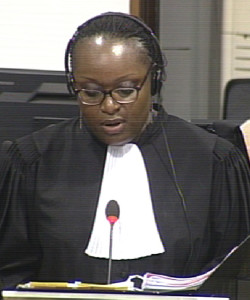
Khieu Samphan Defense Counsel Anta Guissé
Ms. Guissé asked whether he ever went to the rear when he was in the East Zone, or whether he never left the front, as he had said that he met Sao Phim. He replied that he was stationed at the battlefront, but when it “was not so busy” he would come to the Zone to visit his family at the agricultural and production unit. He sometimes visited the rear every two or three months. The units were separate from each other, so they did not discuss matters concerning other regiments. When he was at the battlefront, he “did not care” about any situation at the rear. He visited his family for a day and stay overnight before returning to the battlefront.
Ms. Guissé asked whether it was correct that they sent the severely wounded to another hospital. He replied that his hospital was divided into two: one was situated at the rear and the other part was located at the battlefront to rescue the wounded soldiers. They would then be sent to the rear. His unit was located at the front.
Ms. Guissé asked where his mobile unit was assigned to the first time in 1976 where he was assigned to a battlefield. It was located at Ponhea Kraek District. They did not engage in the battle yet in 1976. Another hospital was located at the front to treat emergency cases. Before 1977, there were no wounded soldiers. “After Phnom Penh fell, my unit was transferred to Svay Rieng in order to join Division 4.” They worked in the rice fields or were assigned to dig dams. At the battlefield, “there were always wounded and dead soldiers.” He did not have the figure of wounded or killed soldiers, since they would be sent to the next hospital after emergency treatment.
Clashes with the Vietnamese
Ms. Guissé presented a document of April 1977, which mentioned clashes in Svay Rieng.[3] It mentioned that twenty soldiers invaded at Dum Knov, in Doron Village in Bassac Commune. He replied that he did not know of these events, since he had left Svay Rieng Province by that time.
Ms. Guissé referred to Chantrea District near Sab Kok and wanted to know whether he knew this district.[4] He replied that he knew it, but was not aware of events happening there. He went to the zone in 1977, and therefore did not know about events there.
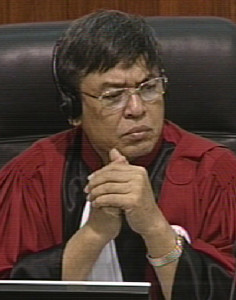
Trial Chamber President Nil Nonn
She said that he had spoken about an incident at Barrack 27, which was the Vietnamese side.[5] She read an excerpt and asked whether he knew Trapeang Phlong. He answered that he had mentioned battlefield on National Road 2. Presiding Judge Nil Nonn interrupted the witness and said that he had to listen carefully to the questions. The witness replied that he knew the location. There was no incursion by the Vietnamese before this incident, but attacks along the border. After the fighting, Vietnamese troops broke 155 and reached Trapeang Pring and beyond that line. “That is why we had to push them back in late 1977.” They spent three days and nights fighting with them, after which the Vietnamese retreated.
Ms. Guissé referred to an incident at Memot. The Vietnamese had entered the territory east to the factory and destroyed property, according to this excerpt.[6] Ms. Guissé asked whether he remembered having heard about this incident on 24 December 1977 and civilians being used as human shields. He replied that he remembered incidences at a rubber plantation, but not at Memot. Memot was with Division 154.
Ms. Guissé asked whether he had heard about a range of locations, but he said that he had not heard about them.[7]
She said that the statement had mentioned the removal of mines. She asked whether he had to treat people who were injured by “those mines.” He replied that his soldiers did not step on those mines and were injured by the fighting. There were no special forces to demine places, he said. Ms. Guissé said that according to his testimony, he had received a letter from the Vietnamese to organize a meeting and wanted to know how they knew who he was and how the letter reached him. He answered that he was stationed somewhere “where it was full of vegetables.” He could not recall the names of all the Vietnamese, but recalled Koy Bienh and Kao Tip. There were “secret agents” who approached and contacted him.
The president interrupted the examination and informed counsel that the time had expired. He then thanked the witness and dismissed him.
New Civil Party: Sar Sarin
Civil Party Sar Sarin, was born on “Tuesday, 7 July” 1957. He presently lives in Village 5, Viel Vong Commune in Kampong Cham District.
Ven Pov said the Civil Party had made a proposal a few days ago, since he had health issues. He asked to be able to participate in the hearing only for half a day each, due to high blood pressure. The president informed the Civil Party that they had failed to inform the Chamber, as they had not scheduled any other Civil Parties or witnesses.
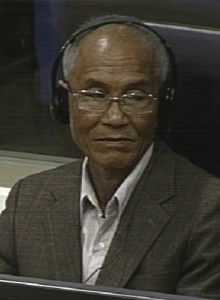
Witness 2-TCW-1065
Mr. Pov asked him to recall the event when he drove the foreign delegates. The president said that the Civil Party lawyer seemed to be testifying by summarizing his statement before having asked questions. Mr. Pov asked the Civil Party where he worked from 17 April 1975 onwards. Mr. Sarin replied that he was responsible to collect food supplies to bring them to soldiers who fought against Lon Nol forces. Later on, the upper echelon wanted to mobilize forces and came to recruit soldiers at the base. Soldiers from Sector 21, 22 and 23 were sent to Sala Sor 200. They were under the supervision of Keo Samnang. They reached Chbar Ampil at some point before reaching the Royal Palace. “It was my first time in town. When I was young, I saw the Independence Monument on the cover of a notebook. When I arrived in Phnom Penh, I could see the real Independence [Monument].” He met Ta Prum, Ta Khy, and Pang at K-7, who recruited them. He was trained at K-15. They recruited around 300 people. They first had to clear the forest and had to sleep under houses. “At the time, the wind blew from the North.”
They were asked about their revolutionary background and he raised his hands to say that he had joined the revolution before 17 April.
“At the time, joining the revolution was like searching an opportunity.” They went to a house in Chamkar Mon that had been burned down. They slept in that house without a roof and instructed to plant vegetables for several days. When he was sent into town, “there were only abandoned cars.”
Visits by Foreign Delegations
The president interrupted the Civil Party and instructed the Civil Party lawyer to ask precise questions. Mr. Pov asked about the location of K-12 and who the chief was. He replied that the headquarters were at the former Mekong Bank. It was reserved for the vehicles that were used by Khieu Samphan, for example. It was the venue to receive foreign guests and presidents from other countries, as well as technical advisors, experts and engineers.
K-12 was supervised by a range of people. Chet, Lang, Chey and Huon were in charge of 100 staff members each. Huon was at Chamkar Mon. K-12 was under direct supervision of the Party Center Office 870. It was mentioned in his laissez-passer. Comrade Pang was mentioned in this document. “It was the size of my cell phone or ID card.” It said “Foreigner Unit under 870.” This office did not have specific headquarters, but was located at K-1. There were no board indicating the offices. There were K-1, K-2, and K-3. K-1 was for Pol, K-2 was used for Ieng Sary, and K-3 for Nuon. K-1 was adjacent to K-2, located in the vicinity of Independence Monument. K-3 “ran along the Independence Monument until Psar Chas.” There were also K-18. K-34 was responsible for the radio communication. K-6 was the political training school. K-7 was the messenger unit to the left of the Royal Palace. His unit, K-12, was the driver unit. He said that there were more than 30 K-offices, but he could not recall them all.

Civil Party Lawyer Ven Pov
“I drove many foreign guests from countless countries. They came to visit Kampuchea annually; Yugoslavia, Korea, China. Korean and Chinese delegates came to visit very often, more often than other foreign guests. There were presidents of Burma and Laos and also the secretary of the Chinese Party, who also came to visit this country. The president of Burma, his name was U Win, made a state visit at the time. It was Khieu Samphan at the time who welcomed this president. The ministers under him [were] also in attendance.”
Mr. Pov asked what position Khieu Samphan held when the president of Burma visited the country. He replied that he was the State President of Democratic Kampuchea and is currently known as head of state. “Usually [a] president was welcomed by [a] president as well.”
Every time presidents or delegates came to visit the country, there were letters presented to these people. He witnessed the ceremony of presenting letters. Khieu Samphan accompanied the president and other delegates to visit the palace and the temple in the palace. “There was a party after that, at Chamkar Mon.” They also watched the arts performance. “At last, there was a farewell party for the guests which was held at the government cabinet in front of Wat Phnom.”
“I was driving the eleventh vehicle. Usually those guests were in another vehicle, from vehicle number 1 until 30. […] I could not go away from my vehicle. I could only see their gestures. […] They were in conversations. I drove Burmese guests, and after they got off the vehicle, they went to see other guests. Khieu Samphan was a very active man, he walked very fast to welcome the guests. There were Cheam and Chien, who were there already to open the vehicle doors for Khieu Samphan. I was very far from them, I did not hear directly what they said.”
Mr. Pov asked whether he also drove them to the countryside. He replied that he only drove them to Pochentong after they went to Siem Reap. Another convoy took them from there. Khieu Samphan was there to visit Angkor, but the Civil Party did not accompany them. Every time there was a presidential delegate, there would be someone to greet them at Pochentong, including the delegates and Uncle Nuon. To his knowledge, Nuon Chea was the president of the People’s Assembly.” At that time, it was not difficult to identify that position, because it was published in a magazine and broadcasted in the radio.”
After the conclusion of this visit, they greeted the Laotian delegates, during which Khieu Samphan was also present. They visited Angkor Wat and Bayon Temple. “After that, the Premier or the Party Secretary of China, Chiang Ching-kuo, alias Chhay, visited the country.” Khieu Samphan did not greet them, but Pol Pot did. They visited all zones and the party secretary returned after two weeks.
Study Sessions
In around mid-April, there was a political study session. The first study session he attended took place in late 1975 at a technical school. The school belonged to the center. He studied there under the instructions of Comrade Phoum. A year later, he attended another study session led by Khieu Samphan and Nuon Chea at Borei Keila. Both gave instructions in a study session. “They spoke about the history of the resistance of the Communist Party of Kampuchea.” They were mistreated by the French and suppressed, they said, until the 1940s. At this time, they were told, there was a resistance movement called the Issarak Movement. Another resistance movement formed at this time as well. They said that “there were only seven individuals who formed the core of the Party.” At the time, the enemy did not pay attention to such gathering. “Major party members came from various zones and sectors to attend such meeting.” The party indicated P’chum Ben, 28 September, as the date of the inauguration of the party. “They also made mention that we could not live in Phnom Penh City and that we had to flee to the jungle.” They were told that they had to “rebuild ourselves anew.”
Nuon Chea
He continued: “In the party ranks, there were traitors, so they had to be filtered and smashed.” There was a slogan that hung somewhere mentioning the smashing of American, KTB and Vietnamese infiltrated enemies. They were told that there were remnants of those infiltrated people amongst the evacuees and “for that reason, they had to be cleansed […] so that this traitorous network could be abolished.” The same applied to former Lon Nol officials: “They had to be cleansed.” Moreover, “those who were in conflict with the CPK” also had to be smashed, including students. Mr. Sarin said that “he also spoke about other sectors.” “He spoke about being vigilant.”
“He also spoke about only one citizen within the nation, that is to have Khmer citizenship only. He said that in Kampuchea, there were 16 citizenships and I cannot recall all Cham, Kuy, Samre, Kuvet, Stieng, et cetera. But he said that due to the humble and honest nature of [Khmer] people, there should be only one citizenship of Khmer people. As for religion, there should be no religion, including the Cham or the Buddhist religion, or any ethnic tradition, because that would not be of any benefit for the construction of the country.”
“As for the education sector, he said that we should only study up to the level that we could know how to read and write, and it would be better to learn through practice.”
Mr. Sarin was in the vehicle unit, “so what he said that wherever we were, we should study through practice.” He never heard about bachelor or master degrees during the time, and only heard about. Those who were “very intelligent,” he said, “maybe they were subject to be under monitor.” There was a slogan that they “had to be absolute to produce three tons of rice per hectare.” Education should link to the sport sector. They were not meant to compete abroad, but to engage into rice farming. As for treatment of illnesses, “they only relied on our herbal medicine.” Regarding rice production, he said: “We had to plant, plant, and plant everywhere.”
Nuon Chea spoke about the “enemies” and there were four kinds of enemies; he cited CIA agents and KTB agents (those who came from their overseas studies in the former Soviet Union and the Northern Part of Vietnam), “and they were the targets from the party to be purged.” Another type of enemy were the enemies against the 6th Moral Principle. “He referred to leaders within the party, including Koy Thuon.” He said that Nuon Chea mentioned that Koy Thuon “had a secret love affair with a former art performer, and the secret was leaked, maybe by his former messenger.” Koy Thuon took away his messenger and killed him. Koy Thuon “had a secret plan to kill Pol Pot in order to take over his power.” They said that an individual who secretly fell in love with someone would later betray the Party. “There were Koy Thuon, there were Comrade Doeun, who was the office committee of Office 870 […] and there was Comrade Sot, who was in Sector 106 in Siem Reap, Oddar Meanchey, there was Chan Chakrei, who was the military commander in the East Zone. So these people were kind of systematic.” They said that if anyone was linked to this traitorous network, they should confess. “The Party was the mother, the Party was the father.” Nuon Chea had said that if anyone confessed, they would be forgiven and not be punished. If someone concealed this fact and it was found out, “the party would take measures to dig out the roots.”
Many people raised their hands. “Since there were too many, then they had to include this information in their biography.” Around ten to fifteen people were linked to this traitorous networks, he said.
At this point, the President adjourned the hearing for a break.
Khieu Samphan
After the break, the president informed the parties that So Sarin was in good health according to the duty doctor. However, if the Civil Party thought he had health issues, the hearing could be adjourned.
The questioning then resumed. Mr. Pov inquired about Khieu Samphan. He said that Khieu Samphan mentioned “the tragedy caused by the American imperialists.” Khieu Samphan had mentioned “300 days and nights that B-52 were dropped onto the territory.” He said that 66 million tons of bombs were dropped onto the territory. Calculated by the population, one individual was bombed by seven tons of bombs. Khieu Samphan had also mentioned the holocaust, Mr. Sarin said. They were referring to the yuon that caused the destruction. “He said that the country were claiming on their respective ownership of properties.” “He said that yuon [were] jealous.”
Moreover, “he encouraged all of us that we had to be wise,” he said. “He said that our party was a clever one. Our party had evacuated Vietnamese […] to their own country. Moreover, he said that yuon were very clever in breeding their own people, and yuon were encouraging their own people to marry Kampuchean people historically. And he said that we had to smash, sweep clean all yuon.” Khieu Samphan had also mentioned the donations by other countries that Cambodia had never received. “He said that usually, the donations and grants came with the CIA conditions.” Moreover, “not using money was also mentioned by him […], otherwise enemies could buy our hearts.” Mr. Sarin said that Khieu Samphan had given the example of the accounting staff and cashiers and mentioned the social security scheme.
He continued saying that Khieu Samphan had said that they needed to increase the population from ten to twenty million in fifteen years. “To achieve this, we needed to organize collective weddings. And to be able to be married, women had to reach 22 years old, and as for men, they had to be in the age of 25 and up. Weddings had to be organized collectively. They could not go and propose anyone. Party would be the one organizing the wedding and choose partners for them. And he made mention that Party was afraid of men and women were linked to traitorous lines, or were suffering from tuberculosis.”
He could recall that “we have to save. If each and everyone of our comrades can find stuff, although it is small, if we can find old knives, axes, and ion material, we should collect them all and put in one pile.” He also said that each cooperative and unit, “we had to be equipped with the saving principle and innovative idea.” He gave the example of on how to cook. “He said that we needed to have three dishes for meal, namely for example rice, fish sauce and soup. As far as we are concerned, we, the Cambodian people, faced insufficient food.” On special occasions he would have thick rice, he said.
He attended the anniversary study session in Borei Keila in 1977. “The two uncles gave the speeches.” The study sessions had taken place before this anniversary celebration of 17 April. The anniversary celebration took place at the Olympic Stadium, but he did not attend the ceremony itself.
Other Meetings
The chiefs of small units attended the meeting. Later, when he returned to his office, people disappeared. Later on, there was an intensified conflict with Vietnam, he said. The office assigned him to transport ammunition in Kampong Cham. “I went in perhaps early 1978, January or February.” Pang and Sam told him that “Comrades with good biographies should be selected to be in charge of ammunition warehouses in Kampong Cham.” He continued: “In June, there was an event in the East. It was said that Sao Phim committed suicide and conducted a traitorous movement. From that moment I was not allowed to go to the East.” He met a person in the east who lived in an adjacent village, who told him that people from the East had all been arrested. “Because of that news, I was prevented from going to the east.”
As for House 1 and House 2, they belonged to B-1, he said. B-1 was in charge of these houses and they were part of the Ministry of Foreign Affairs. House 1 was located to the east of Wat Phnom and used for presidential delegates. House 2 was close to the Royal Palace opposite of the university where other delegates were allowed to reside. “Journalists, for example from Sweden, were allowed to stay at House 3.” Technical groups stayed there as well. Chinese technicians stayed at House 4. House 5 was “for the anti-drug committee” and “housed thousands of Chinese workers. These workers were also used at rubber plantations.
With this, Mr. Pov concluded his line of questions.
Former Lon Nol Soldiers
The floor was handed to the Office of the Co-Prosecutors. Senior Assistant Prosecutor Dale Lysak inquired about Lon Nol officials. The Civil Party replied that after the liberation on 17 April, a unit walked people in his commune. Food supply was distributed to the battlefield. However, when the fighting seized, rice was given to Lon Nol soldiers. He saw them and have a conversation with them. “We had a casual conversation. Then I was warned not to be close to them, because they were enemies.” At this place, over 100 soldiers were gathered. Asked how he could identify them, he said “that it was not so difficult. […] They were sent from the battlefield and they were wearing military attire.” Mr. Lysak read an excerpt of his statement, in which he had said that he was tasked with guarding of 200 soldiers. Mr. Lysak asked whether he had been assigned to do so, and if yes, who had given him this assignment.[8] He answered that it was correct and that the tower was located opposite of Kampong Cham. Bong Nhim, who was chief of the militia, assigned him to do so. They were held for about two months. After this period, “those soldiers were sent and Brother Nhim whispered to me that they were taken away to be killed. And all soldiers throughout the country were killed. We kept them for two months in order to wait for instructions from the upper echelon. In fact, initially they had the principle to disperse them, to send them to various cooperatives, but later on they sent them to so-called study sessions. And initially, only captains and chiefs were sent away on horse carts. […] About a week or ten days after […] when those soldiers were removed, I was no longer there. I was at the messenger’s unit to deliver messages.”
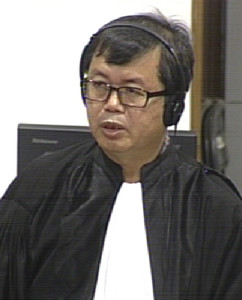
Khieu Samphan Defense Counsel Kong Sam Onn
At this point, Khieu Samphan Defense Counsel Kong Sam Onn interjected and objected on the basis that the treatment of Lon Nol soldiers fell outside the scope of the trial, as it related to 002/01. Mr. Lysak replied that this objection had been overruled many times, as it fell inside the scope of the trial by looking at the policy. The objection was overruled, but no details should be asked about the treatment of Lon Nol soldiers. Mr. Lysak read an excerpt of his statement, in which he had said that Lon Nol soldiers should be smashed.[9] He asked who told him that they were waiting for orders of the center about the treatment of Lon Nol soldiers. Mr. Sarin said that his chief Nhim told him so. This was relayed to him in a meeting. During this meeting, the topic of the treatment of Lon Nol soldiers was discussed. Mr. Lysak asked whether the Lon Nol soldiers who were executed were only those who had ranks, or whether ordinary combatants were also executed. He replied that initially, chiefs were taken away on horse carts. Later, they were taken away during night time and disappeared. “I did not ask for any further details regarding these people. We did not dare to discuss this matter, because we me might be taken away as well.”
He did not know the details. He knew that chiefs were taken away first. He did not know who the district chief was at the time.
Mr. Lysak quoted Uk Bunchhoeun, who had said that Pol Pot issued a secret policy in April 1975 to wipe out sub-district level Lon Nol civilian officials and second lieutenant and upwards Lon Nol soldiers.[10] Mr. Lysak asked whether he had heard about the difference made based on the rank of Lon Nol soldiers. At this point, Nuon Chea Defense Counsel Victor Koppe interjected. He objected to “the very selective use of evidence.” He said that Heng Samrin had also talked about this meeting and had said that they “should be taken out of the framework.” Mr. Lysak said that it was not selective evidence, and that Ben Kiernan had interviewed six people, who had used the word komtech, while Heng Samrin had used the word komchat. The objection was overruled.
Mr. Lysak asked him about the use of the word “whisper” that he had used when Nhim told him something about the Lon Nol soldiers. He said that he received the information during a meeting. He whispered this on the way to a forest in Svay Yat. Some were said to have been sent to Baray Sla Do and to Svay Yat to cut the forest. Others said that these people had been “sent to study.”
Mr. Lysak then moved on to the issue of religion under the Khmer Rouge and asked what happened to monks and pagodas while he was in his home district in 1975. The Civil Party recounted that after 1975, there were no more monks and that all religion was abolished. They had sent them to the center and he met a few of them later again. One pagoda in his village was used to house soldiers. It was close to Psar Suong. Another pagoda south to Suong was along the road and located around five kilometers away. Monks from these two pagodas were defrocked. “I can say that at the time, all monks had been defrocked. During the time, we were not allowed to move freely. Only I could move from villages from villages by riding a bicycle.” They needed to show a letter when going to another village. Those who died were buried without any ritual ceremonies. He compared this to being buried like animals.
Mr. Lysak turned to the period after he arrived in Phnom Penh and asked about his political training after he arrived in Phnom Penh. He said that there was a political training session at K-15, the Khmer-Soviet technical school that was conducted by Comrade Phoum. “He had always a smiling face. His voice was soft and very nice to hear.” He was not aware of his position, since it was secret. “All I know is that he was a trainer at K-15 School. Again, I had no idea whether or not he held a position in the party.” At this point, the president called for a break.
Unit Leader
After the break, Mr. Lysak asked whether he contacted Ta Phoeum and knew what happened to him later in 1976. He replied that there was only a Ta Phoum and not Ta Phoeum. Later on, he disappeared, he said. “He was likely to be purged by the Communist Party of Kampuchea.” Mr. Mr. Lysak said that Mao Kem Nuon, alias Phoum entered S-21 on April 5, 1977. Mr. Lysak asked whether he knew Ta Phoum’s full name.[11] He replied that he did not know the full name. He said that the content of the study session was on the elimination of individual property “in order to continue our revolutionary movement.” The individual wanted to gather many materials and properties, as they were scattered around by those people who left Phnom Penh City. During the meeting, they said that they “should get rid of all of this.” Cadres from the low-west attended a study session and the content of the session was about feudalism. “He was the one who led the delegation.” He said that it was likely that he was arrested around April 1977, since he was no longer there in the study session that he attended.
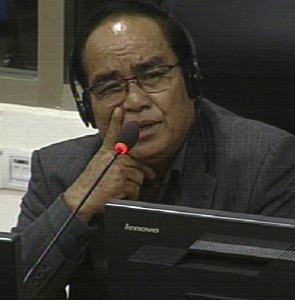
Civil Party Sar Sarin
Mr. Lysak asked which parts of the country he remembered driving the cadres to. They had to request additional vehicles for the trop, Mr. Sarin said. Even seven or eight busses were not enough. Voy asked them to find mattresses. The rice field was ripe at the time and the production good during that year. They were called to learn from other districts. They visited Svay Rieng Province and visited dams, rice fields and rubber plantations. After this, they went to Sralab Commune in Tboung Khmum, located in Sector 21. They also visited Chhub Rubber Plantation. Mr. Lysak interrupted the Civil Party and asked for the general zones or provinces that he went to.
Back to Visit of Foreign Delegates
He replied that they went to the East Zone, the Central Zone and Siem Reap, Oddar Meanchey, as well as Angkor Wat, the West Zone, the Southwest Zone (Takeo and Kampot), the coastal area, and then the West Zone again at Kampong Speu.
While he was driving Ta Phoum, he heard him talking about another person, but there were many vehicles. He was in his jeep with a few bodyguards and drivers to greet their convoy. They then went to Sisophon, and only saw him from afar during that trip.
When they came to receive the guests, he saw them “in their active performance” and the delegate was not allowed to “visit any bad place”, which was why they did not know anything about food shortages. They showed them machines for them to copy the models.
At this time, he was assigned to work in Kampong Cham.[12] Some people begged for rice from them. There were some people who were emaciated on the side of the road. They saw some child workers as well.
Mr. Lysak asked whether he also received training from Ieng Sary on how to handle foreign delegations. He replied that he initially did not attend the study sessions and only did so when they received presidential representatives. They were then instructed to attend study sessions at B-1. The location compound was on the junction of the main road and Kampuchea Krom Boulevard. “We all should not dress in black attire and that we had to wear military form […] and also we had to wear dark green uniforms as the uniforms worn by the police.” Ieng Sary told them to go to the garment factory at Orussey and have two set of clothes tailored for them. They should wear proper clothing and not car-tire thongs anymore. “We were given nice trousers, and long sleeve shirts, and good shoes.” They were advised to have sufficient food and goods and receive it from the “foreign market” at a hotel. They were told to contribute “in order to succeed.” Because of insufficient food, “I was hungry all the time.” As Khieu Samphan indicated in his speech, he spoke about three dishes per day.
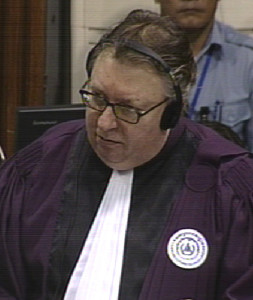
International Deputy Co-Prosecutor Dale Lysak
Mr. Lysak asked whether Ieng Sary gave them any instructions on what to say if people from the foreign delegations asked him about food supplies for the workers. Mr. Sarin answered that they said that they did not have enough to eat. “He made mention that all people voluntarily went to engage in agricultural production.” He said that the guests “usually spoke Khmer” and that he sometimes spoke with them about some of the issues. “Usually guests in my vehicle asked me this and that.”
Mr. Lysak said that he had told the investigators that he was told that people volunteered to work in agricultural production and that “things were good when they were not.”[13] He answered that his unit chief told him so. He did not know whether his unit chief received instructions or drew up the instructions himself. There were meetings held on a daily basis.
They had base themselves “on the principle of criticism and self-criticism.” The title of the speech was “in order to sweep away infiltrated enemies, we have to rely ourselves on principles of criticism and self-criticism and also on the principle of solid stance.” The meetings were held for five to ten minutes. Meetings with the bigger group were held once every three days and the meetings in smaller groups once a month. “The meetings were to prevent the inside enemy to destroy all of us.” He said he may have confused the study sessions by Khieu Samphan and Ieng Sary. Workers were still required to grow vegetables in order to sustain their own food supply.
Mr. Lysak asked whether he accompanied the Chinese delegation and went to the 1st of January Dam and Trapeang Thma Dam, which the witness confirmed. “To my recollection, we had lunch under a palm tree.” At this time, the dam was not completely built. At 1st January Dam, “they were working in rows like ants,” he said. This was not the same at Trapeang Thma, since the harvesting had already been done. “Pol Pot was in attendance, but not Uncle Nuon and Uncle Khieu Samphan: They were on duty.” Since he was representing the guest countries, he was always with the Chinese delegation and accompanied them all along.
Mr. Lysak read an excerpt and asked whether Pol Pot was followed by Vorn Vet and Ke Pauk, which the witness confirmed.[14] “When we arrived at the zone, we would be welcomed by the zone committee, since leaders of Phnom Penh were there.”
He was assigned to drive Comrade Mien during the trip of the Chinese delegation. When he arrived at Suong, “his driver was so slow and the vehicle with the film makers on it was too slow, so I was assigned to drive the vehicle transporting [the] film crew. The film crew usually took photos and films of the guests.” They were assigned to the “fast boat” to see the maritime border.
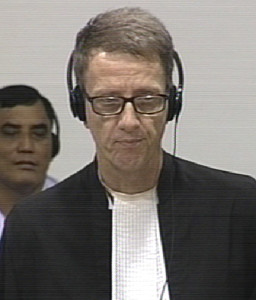
International Nuon Chea Defense Counsel Victor Koppe
At this point, Mr. Koppe observed that it was “the first witness [sic] of the last segment on the role of the accused.” He had not heard a single question about the role of the accused by the Co-Prosecutors. “I find it a complete waste of time.” Mr. Lysak said he was “not interested in insults from the other side” and that the Civil Party had significant knowledge about some other relevant parts. Mr. Lysak asked whether someone from his office was assigned to drive the delegation. The Civil Party answered that the vehicles were parked at K-12. When the leaders accompanied guests, they would use modern vehicles. “The vehicles at my unit were used to drive local and international guests. “Wives of leaders never used those vehicles.” They had the principle to “save a lot of expenditures,” he said. Some of those who had committed mistakes or crashed a car “would disappear.” He had not inquired, however, what happened to those. “I did not tell about my suffering and what happened to me, because of the time, Mr. Prosecutor.”
The president adjourned the hearing, which will continue Thursday, November 10, 2016, at 9am with the testimony of 2-TCCP-913, followed by 2-TCCP-235.
[1] E3/10667.
[2] E3/10667, at answer 7.
[3] E3/852, at 00386227 (FR), 00183715 (EN), 00021519 (KH).
[4] E3/889, at 00386262 (FR), 00183616 (EN), 00020877 (KH).
[5] E3/891, at 00386265 (FR), 00183617 (EN), 00020878 (KH).
[6] E3/908, at 00183638 (EN), 00020923 (KH), 00386278 (KH).
[7] E3/10669.1, at 00611727 (FR), p. 278, 00020943 (KH), 00183646 (EN).
[8] E3/5783, at 00482778 (KH), 00739510 (EN), 00746460 (FR).
[9] E3/5783, at 00482778 (KH), 00739511 (EN), 00746461 (FR).
[10] E3/387, at 00379486 (KH), 00350205 (EN), 00441418 (FR).
[11] E3/1859.
[12] E3/5782, at 00482800 (KH), 00739523 (EN), 00746479 (FR).
[13] E3/5783, at 00428812 (KH), 00739544 (EN), 00746487 (FR).
[14] E3/1339, at 00168335 (EN), 01169188 (KH), no French translation.
Featured Image: Civil Party Sar Sarin (ECCC: Flickr).
